Nikhil Prasad Fact checked by:Thailand Medical News Team Dec 31, 2024 3 months, 2 weeks, 11 hours, 50 minutes ago
Medical News: The Foundation of the cGAS-STING Pathway
The COVID-19 pandemic has profoundly affected the world, with millions of cases and fatalities reshaping public health priorities. Among the many scientific efforts to understand this disease, researchers have zeroed in on the complex interplay between the virus and the immune system. A significant area of focus is the cyclic GMP-AMP synthase-stimulator of interferon genes (cGAS-STING) signaling pathway. This pathway is part of the body’s innate immune response, essential for detecting viral invaders and initiating defenses.
 The dual role of cGAS-STING signaling in COVID-19 and potential therapeutic targeting. In the early phase of infection, the virus can suppress cGAS-STING signaling to evade immune detection. Thus, cGASSTING agonists are beneficial at this stage, in order to reduce viral replication and control infection. However, in the late stages, activation of this pathway can lead to excessive inflammation and tissue damage, exacerbating disease severity. In this case, therapy might antagonize cGAS-STING
The dual role of cGAS-STING signaling in COVID-19 and potential therapeutic targeting. In the early phase of infection, the virus can suppress cGAS-STING signaling to evade immune detection. Thus, cGASSTING agonists are beneficial at this stage, in order to reduce viral replication and control infection. However, in the late stages, activation of this pathway can lead to excessive inflammation and tissue damage, exacerbating disease severity. In this case, therapy might antagonize cGAS-STING
In the Department of Biological Sciences at the Bauru School of Dentistry, University of São Paulo, Brazil, researchers led by Daniele Castro di Flora, João Paulo Zanardini Lara, and Marília Afonso Rabelo Buzalaf have explored the dual role of the cGAS-STING pathway in COVID-19. This
Medical News report delves into their findings and examines the implications for future therapies.
Unraveling the Mechanisms of cGAS-STING
The cGAS-STING pathway serves as a sentinel, identifying foreign DNA in the cytoplasm - a signal that an intruder, such as a virus, is present. Upon activation, this pathway triggers the release of interferons (IFNs) and other molecules to neutralize threats. However, SARS-CoV-2, the virus responsible for COVID-19, has developed strategies to manipulate this pathway, showcasing its dual role in the disease.
At the onset of COVID-19, the virus suppresses the cGAS-STING pathway, evading detection and facilitating its replication. This clever suppression ensures minimal immune interference during the critical initial stages. As the disease progresses, however, a different story unfolds. The fusion of viral and host cell membranes generates cellular debris, activating the cGAS-STING pathway. This late-stage activation leads to an overwhelming inflammatory response, which, rather than combating the virus, damages tissues and exacerbates symptoms.
Key Findings from the Study
The researchers conducted an extensive review of previous studies and experimental data, analyzing the nuanced role of the cGAS-STING pathway. They found:
-Initial Suppression by SARS-CoV-2:
Viral proteins such as ORF3a and ORF9b inhibit the cGAS-STING signaling. This suppression reduces IFN production, allowing the virus to thrive undetected.
-Delayed Activation in Severe Cases:
gt;
The formation of multinucleated cells, or syncytia, during later stages of infection leads to DNA damage. This activates the cGAS-STING pathway, increasing IFN production but also driving a hyperinflammatory response.
-Implications for Immune Modulation:
Targeting this pathway at different disease stages may offer therapeutic benefits. Early-stage activation of cGAS-STING could enhance viral detection and immune responses, while late-stage inhibition might reduce inflammation and tissue damage.
Therapeutic Potential and Challenges
The dual role of cGAS-STING presents opportunities for innovative treatments. Researchers highlighted potential interventions:
-STING Agonists: These could be employed early in the infection to bolster the immune response and prevent viral replication. For instance, the compound dimeric amidobenzimidazole (diABZI) has shown promise in reducing viral loads in preclinical studies.
-STING Inhibitors: In severe COVID-19 cases, where excessive inflammation is a concern, inhibitors could mitigate tissue damage. Compounds like inosine have demonstrated the ability to dampen inflammatory responses by targeting this pathway.
-Enhancing Vaccine Efficacy: Incorporating cGAMP, a natural activator of STING, into intranasal vaccine formulations has shown to significantly boost antibody production, offering enhanced protection against SARS-CoV-2 variants.
Despite these promising avenues, challenges remain. Fine-tuning the activation or suppression of cGAS-STING requires a nuanced understanding of its role at different disease stages. Overactivation or inappropriate inhibition could lead to unintended consequences, such as inadequate viral control or persistent inflammation.
Broader Implications for Immunology
The insights gained from studying the cGAS-STING pathway in COVID-19 extend beyond this single disease. Similar mechanisms may be involved in other viral infections and inflammatory conditions. Understanding how pathogens exploit immune pathways can pave the way for broader therapeutic applications, enhancing our ability to combat emerging infectious diseases.
Conclusions
The findings of this study underline the importance of context in immune modulation. The cGAS-STING pathway’s dual role exemplifies the fine balance the immune system must maintain between attacking invaders and preserving the host's tissues. In COVID-19, the virus’s ability to manipulate this pathway highlights its sophistication and adaptability.
Therapeutic strategies targeting cGAS-STING could revolutionize COVID-19 treatment. Early intervention with agonists might halt viral spread, while timely administration of inhibitors could prevent severe complications. These approaches, however, must be carefully calibrated to the stage and severity of the disease.
Future research should focus on refining these therapeutic strategies, exploring their efficacy in clinical trials, and extending these insights to other diseases. By deepening our understanding of immune pathways like cGAS-STING, we can develop interventions that not only combat diseases but also fortify our defenses against future pandemics.
The study findings were published on a preprint server and are currently being peer reviewed.
https://www.preprints.org/manuscript/202412.2307/v1
For the latest COVID-19 News, keep on logging to Thailand
Medical News.
Read Also:
https://www.thailandmedical.news/news/study-finds-that-rna-virus-derived-components-are-able-to-regulate-of-cgas-sting-signaling
https://www.thailandmedical.news/news/shandong-university-study-uncovers-that-sars-cov-2-orf9b-antagonizes-type-i-and-iii-interferons-by-targeting-components-of-signaling-pathways
https://www.thailandmedical.news/articles/coronavirus
